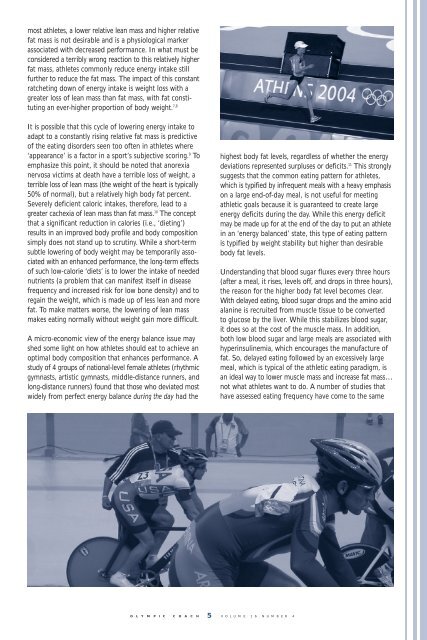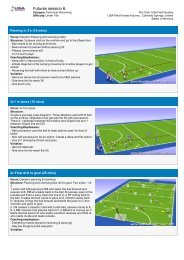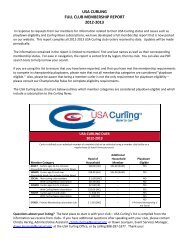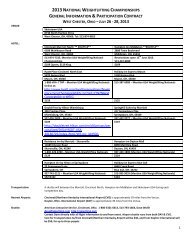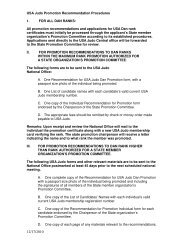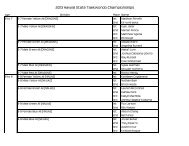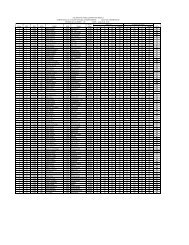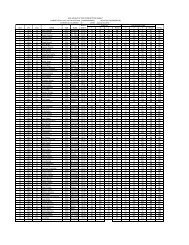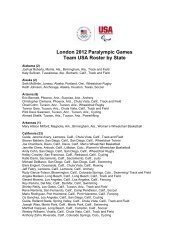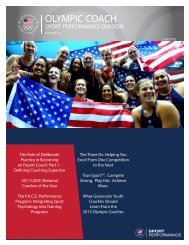OLYMPIC COACH - United States Olympic Committee
OLYMPIC COACH - United States Olympic Committee
OLYMPIC COACH - United States Olympic Committee
You also want an ePaper? Increase the reach of your titles
YUMPU automatically turns print PDFs into web optimized ePapers that Google loves.
most athletes, a lower relative lean mass and higher relative<br />
fat mass is not desirable and is a physiological marker<br />
associated with decreased performance. In what must be<br />
considered a terribly wrong reaction to this relatively higher<br />
fat mass, athletes commonly reduce energy intake still<br />
further to reduce the fat mass. The impact of this constant<br />
ratcheting down of energy intake is weight loss with a<br />
greater loss of lean mass than fat mass, with fat constituting<br />
an ever-higher proportion of body weight. 7,8<br />
It is possible that this cycle of lowering energy intake to<br />
adapt to a constantly rising relative fat mass is predictive<br />
of the eating disorders seen too often in athletes where<br />
‘appearance’ is a factor in a sport’s subjective scoring. 9 To<br />
emphasize this point, it should be noted that anorexia<br />
nervosa victims at death have a terrible loss of weight, a<br />
terrible loss of lean mass (the weight of the heart is typically<br />
50% of normal), but a relatively high body fat percent.<br />
Severely deficient caloric intakes, therefore, lead to a<br />
greater cachexia of lean mass than fat mass. 10 The concept<br />
that a significant reduction in calories (i.e., ‘dieting’)<br />
results in an improved body profile and body composition<br />
simply does not stand up to scrutiny. While a short-term<br />
subtle lowering of body weight may be temporarily associated<br />
with an enhanced performance, the long-term effects<br />
of such low-calorie ‘diets’ is to lower the intake of needed<br />
nutrients (a problem that can manifest itself in disease<br />
frequency and increased risk for low bone density) and to<br />
regain the weight, which is made up of less lean and more<br />
fat. To make matters worse, the lowering of lean mass<br />
makes eating normally without weight gain more difficult.<br />
A micro-economic view of the energy balance issue may<br />
shed some light on how athletes should eat to achieve an<br />
optimal body composition that enhances performance. A<br />
study of 4 groups of national-level female athletes (rhythmic<br />
gymnasts, artistic gymnasts, middle-distance runners, and<br />
long-distance runners) found that those who deviated most<br />
widely from perfect energy balance during the day had the<br />
O L Y M P I C C O A C H<br />
5<br />
highest body fat levels, regardless of whether the energy<br />
deviations represented surpluses or deficits. 11 This strongly<br />
suggests that the common eating pattern for athletes,<br />
which is typified by infrequent meals with a heavy emphasis<br />
on a large end-of-day meal, is not useful for meeting<br />
athletic goals because it is guaranteed to create large<br />
energy deficits during the day. While this energy deficit<br />
may be made up for at the end of the day to put an athlete<br />
in an ‘energy balanced’ state, this type of eating pattern<br />
is typified by weight stability but higher than desirable<br />
body fat levels.<br />
Understanding that blood sugar fluxes every three hours<br />
(after a meal, it rises, levels off, and drops in three hours),<br />
the reason for the higher body fat level becomes clear.<br />
With delayed eating, blood sugar drops and the amino acid<br />
alanine is recruited from muscle tissue to be converted<br />
to glucose by the liver. While this stabilizes blood sugar,<br />
it does so at the cost of the muscle mass. In addition,<br />
both low blood sugar and large meals are associated with<br />
hyperinsulinemia, which encourages the manufacture of<br />
fat. So, delayed eating followed by an excessively large<br />
meal, which is typical of the athletic eating paradigm, is<br />
an ideal way to lower muscle mass and increase fat mass…<br />
not what athletes want to do. A number of studies that<br />
have assessed eating frequency have come to the same<br />
VOLUME 16 NUMBER 4


